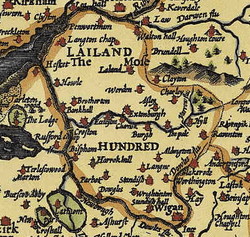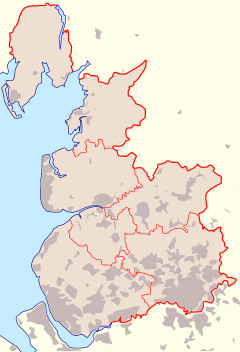Leyland Hundred
The Leyland Hundred (also known as Leylandshire) is a historic subdivision of the English county of Lancashire. It covered the parishes of Brindle, Chorley, Croston, Eccleston, Hoole, Leyland, Penwortham, Rufford, Standish and Tarleton.[1]
| Hundred of Leyland | |
|---|---|
| Lancashire Hundred | |
 | |
 Leyland Hundred depicted in John Speed's 1610 map of Lancashire | |
| Area | |
| • 1831 | 79,990 acres (324 km2) [1] |
| • Coordinates | 53.686°N 2.657°W |
| History | |
| • Created | Before Domesday |
| • Abolished | Mid-18th century, never formally abolished |
| Status | Ancient Hundred |
| • HQ | Eccleston |
| Subdivisions | |
| • Type | Parish(es) |
| • Units | Leyland • Penwortham • Brindle • Croston • Hesketh-With-Becconsall • Tarleton • Rufford • Chorley • Hoole • Eccleston • Standish |
Hundreds of Lancashire
In the Domesday Book it was recorded as 'Lailand' hundred which was included in the returns for Cheshire.[2] However, it cannot be said clearly to have been part of Cheshire.[3][4][5]
Notes and references
- "Leyland Hundred through time". visionofbritain.org.uk. GB Historical GIS / University of Portsmouth. Retrieved 20 January 2016.
- Morgan (1978) page 270a.
- Harris and Thacker (1987). write on page 252:
Certainly there were links between Cheshire and south Lancashire before 1000, when Wulfric Spot held lands in both territories. Wulfric's estates remained grouped together after his death, when they were left to his brother Aelfhelm, and indeed there still seems to have been some kind of connexion in 1086, when south Lancashire was surveyed together with Cheshire by the Domesday commissioners. Nevertheless, the two territories do seem to have been distinguished from one another in some way and it is not certain that the shire-moot and the reeves referred to in the south Lancashire section of Domesday were the Cheshire ones.
- Phillips and Phillips (2002). pp. 26–31.
- Crosby, A. (1996). writes on page 31:
The Domesday Survey (1086) included south Lancashire with Cheshire for convenience, but the Mersey, the name of which means 'boundary river' is known to have divided the kingdoms of Northumbria and Mercia and there is no doubt that this was the real boundary.
Bibliography
- Crosby, A. (1996). A History of Cheshire. (The Darwen County History Series.) Chichester, West Sussex, UK: Phillimore & Co. Ltd. ISBN 0850339324.
- Harris, B. E., and Thacker, A. T. (1987). The Victoria History of the County of Chester. (Volume 1: Physique, Prehistory, Roman, Anglo-Saxon, and Domesday). Oxford: Oxford University Press. ISBN 0197227619.
- Morgan, P. (1978). Domesday Book Cheshire: Including Lancashire, Cumbria, and North Wales. Chichester, Sussex: Phillimore & Co. Ltd. ISBN 0850331404.
- Phillips A. D. M., and Phillips, C. B. (2002), A New Historical Atlas of Cheshire. Chester, UK: Cheshire County Council and Cheshire Community Council Publications Trust. ISBN 0904532461.
gollark: Wow, that is SEVERAL more bots than I remember.
gollark: I dialled yet another server.
gollark: --apiotelephone dial MatsWidenBacon
gollark: --apiotelephone setup
gollark: Yes, you can.
This article is issued from Wikipedia. The text is licensed under Creative Commons - Attribution - Sharealike. Additional terms may apply for the media files.
